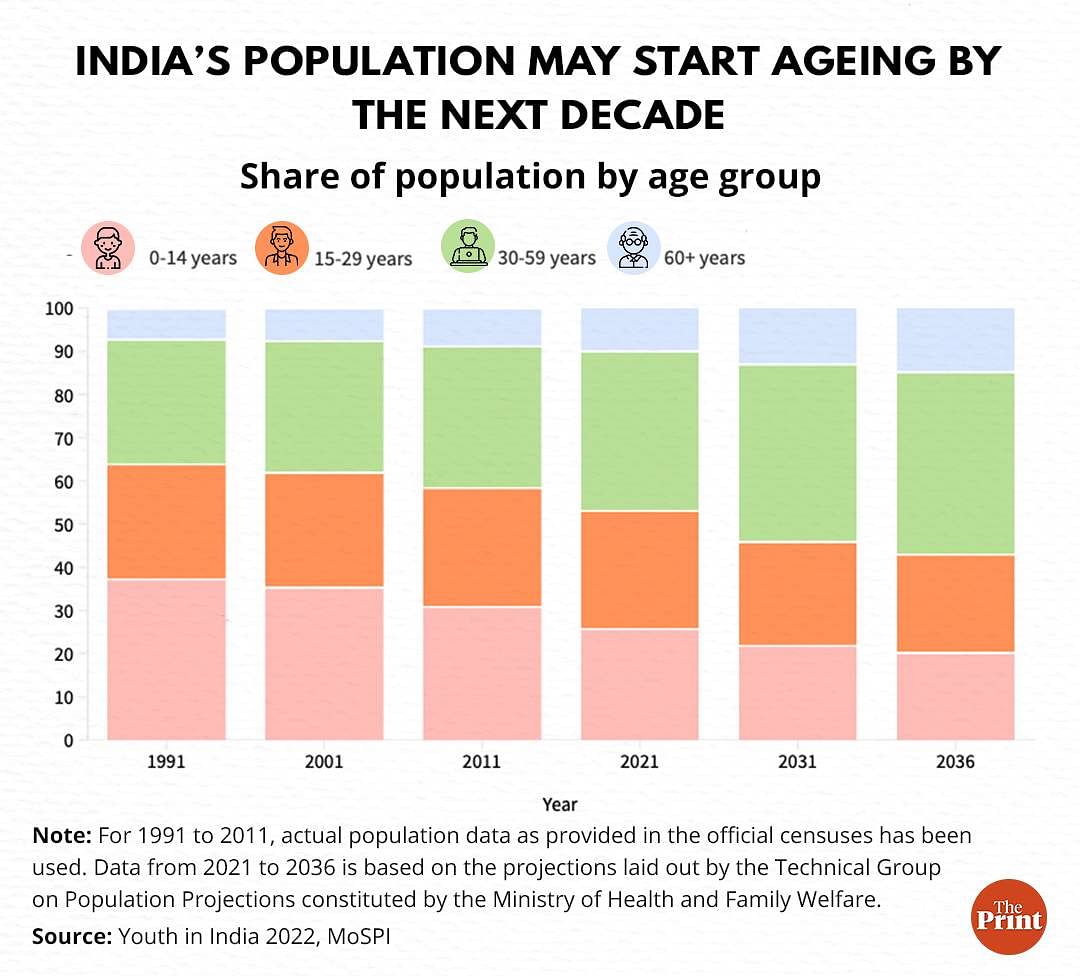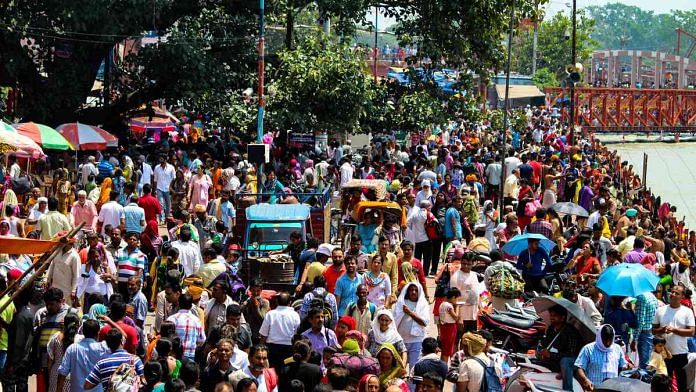New Delhi: Going by the data provided by the last three censuses, the young population of India — those aged 29 and below — has outnumbered those aged 30 and above. But it seems things are about to change.
According to a report titled Youth in India 2022, released last month by the Ministry of Statistics and Programme Implementation (MoSPI), by the year 2036, those above the age of 30 will form the majority of the country’s population. “Youth”, in the report, refers to people in the 15 to 29 age group, as defined in the Centre’s National Youth Policy, 2014.
The report is based on numbers provided by the Technical Group on Population Projections (TGPP) constituted by the Ministry of Health and Family Welfare (MoHFW). The TGPP has laid down population projections for India and its states till 2036, using the Census 2011 data as its base.
According to the Census 2011, over 58.3 per cent of the country’s population is aged 29 years or below, with those in the category of 30 and above making up about 41.4 per cent (the remaining .3 per cent did not state their age during the census exercise).
Now, the population projections in the MoSPI report show that the decade of 2021-2030 is likely to be the point of inflection, essentially a turning point, for the country’s demographic.
Overall, India’s young population, it says, is likely to decline by 10 percentage points (pp) in the next 15 years — from 52.9 per cent in 2021 to 42.9 per cent in 2036.
In the projections for 2021, over half of India’s population — 53 per cent — comprised youth aged 29 and below, while the remaining 47 per cent were 30 and above.
These age groups will make up 46 per cent and 54 per cent, respectively, of the country’s population by the start of the next decade; and 44 per cent and nearly 57 per cent by 2036, the MoSPI report says.

A detailed break-up reveals that even within the younger age group, India is likely to have fewer kids between the ages of 0 and 14 by 2036, and more people in the ‘youth’ category.
In the Census 2011, those in the 0-14 years category formed 30.8 per cent of India’s population, meaning nearly one in every three Indians was likely to be younger than 14 years old. Those in the 15-29 year age group accounted for 27.5 per cent of the population.
According to the MoSPI report’s projections, the share for these two categories has fallen to 25.2 per cent and 27.3 per cent, respectively. By 2036, those in the 0-14 age category will only make up 20 per cent of the country’s population, with every one in five persons in India being 14 or younger, and the 15-29 age group will account for 22.7 per cent.
The share of the ‘middle-aged’ population, defined as those between 30 and 59 years old, shows an upward trend, according to the projections in the MoSPI report. It projected that by 2021, this group would make up 37 per cent of India’s population, but by 2036, it is expected to go up to 42 per cent.
The share of ‘senior citizens’ (those over 60) was projected to be 10.1 per cent of the total population in 2021, and then up to 15 per cent by 2036.
According to Dr C.M. Lakshmana, professor at the Population Research Centre at the Institute for Social and Economic Change, a Bengaluru-based research institution, there is room for correction.
Lakshmana believes India should take advantage of its young population now, since, according to his own estimates, 65 per cent of the country’s population is still below 35 years of age.
“We should use the present strength of our youth to lead. We must take advantage of the youngsters we have. We need to support them to work in the organised sector, building skilled personnel. We should also stop international migration, or brain drain, which is a great loss to India, but benefits the future of western countries,” Lakshmana told ThePrint.
Also Read: Why India’s population growth will be much slower than predicted — 1.6 billion by 2048
Steepest drop in northeast states, Jammu & Kashmir
The MoSPI report provides population projections for states and Union territories, several of which are expected to face considerable changes when it comes to age demographics.
According to the MoSPI database, the Union territory of Jammu and Kashmir will face the biggest change over the next 10-15 years. In 2021, those aged 29 and below have been projected to make up nearly 53 per cent of J&K’s population, but by 2036, this number is expected to go down to 39 per cent — a significant drop of around 14 percentage points.
The report clubbed the populations of the northeastern states (including Sikkim and excluding Assam) and predicted trends similar to J&K.
Almost 53 per cent of the population in the northeastern states was projected to be below 29 in 2021. By 2036, it is projected to shrink to 13 per cent.
Uttar Pradesh, India’s most populous state, with 60 per cent of the population aged 29 and below going by the projection for 2021, is likely to face a 13 pp decline in its young population — meaning, by 2036, only about 47 per cent in the state will be considered as ‘youth’.
The young population may fall by over 10 percentage points in various other states as well, between 2021 and 2036 — in Uttarakhand by 12.2 pp, West Bengal by 11.5 pp, Telangana by 11.5 pp, Rajasthan by 11.2 pp, Jharkhand by 11.2 pp, Punjab by 10.7 pp, Assam by 10.5 pp, Himachal Pradesh by 10.5 pp, Andhra Pradesh by 10.4 pp, and Maharashtra by 10.1 pp.
India’s youngest state Bihar, where every one in three persons in 2021 is projected to be 29 years old or younger, will face a decline of only 9.4 pp in its young population — from 62.4 per cent in 2021 to 53 per cent in 2036.
This decline is projected to be the slowest in Tamil Nadu and Kerala, where the share of young in the total population is already the lowest. In Tamil Nadu, it is projected to go down from 43.1 per cent in 2021 to 34.6 per cent by 2036, and in Kerala, from 42.5 per cent to 36.9 per cent.
The share of senior citizens in these two states, too, is projected to be the highest. By 2036, nearly 22.8 per cent persons in Kerala and 20.8 per cent in Tamil Nadu should be 60 years or older, says the report.
According to Lakshmana, it is essential for India to leverage its youth population, starting with providing them with skills and jobs.
“To provide employment to this huge population, training centres need to be upgraded, especially for the technology and communication sectors. We must encash this youth dividend right now,” Lakshmana said, adding that the country is currently short on skilled labourers in the organised sector.
Not taking steps towards increasing employment, Lakshmana said, could be harmful for society in general: “Keeping a huge reserve of unemployed young people is not a good idea. With a large number of unemployed youth, the chances of crimes and related activities also rise.”
(Edited by Zinnia Ray Chaudhuri)
Also Read: If Indian states were countries, Delhi beat China’s TFR, but population policy still lost



